International Academy of Detoxification Specialists: Analysis
Last updated on January 26, 2009 09:55, Raymond Hill.
Summary
A paper from Dahlgren et al. claims a 65% reduction in toxic level of various PCB compounds following Scientology's Purification Rundown. Closer scrutiny of the paper shows that no such reduction took place, and hints at deliberate deception.Contents
- Deceitful study used in promoting Scientology's detoxification program
- Two experts comment on Dr. James Dahlgren's deceitful study
- James Dahlgren et al. reply to Drs. Crouch and Green
- Dioxin 2004 vs. NYRWDP study
- Further reading
Deceitful study used in promoting Scientology detoxification program
Is the International Academy of Detoxification Specialists obtaining government grants and public contributions from misrepresenting the value of its detoxification treatment?
A document titled Persistent Organic Pollutants in 9/11 World Trade Center - Rescue Workers: Reduction following detoxification, is used by the New York Rescue Workers Detoxification Project ("NYRWDP") to promote the detoxification treatment designed by L. Ron Hubbard, founder of Scientology. The NYRWDP is a program from the International Academy of Detoxification Specialists ("IADS"). IADS is a secular, Scientology-linked public charity which receives grants from the government for its implementation of the NYRWDP. [Update Jan 3, 2009: The hyperlink to the study no longer appears on the web site. But it used to, as seen in this older version of the web page at archive.org.]
In the study, there is graph (seen below) supposedly showing the level of reduction in a specific type of PCB following Scientology's "Purification Rundown".
Not only the study is flawed (no control group, small sample), but the graph is deceitful (figure 1): the "pre-detox" values were obtained from adding up all dioxin and PCB levels (26 chemicals), while the "post-detox" values were obtained from adding up only the mono-ortho PCB levels (8 chemicals). The real graph, one comparing only pre- and post- mono-ortho PCBs, and using NYRWDP data, is shown below (figure 2):
From the study used in support of the New York Rescue Workers Detoxification Project |
Here is how the graph should look, reporting only mono-ortho PCB levels |
||
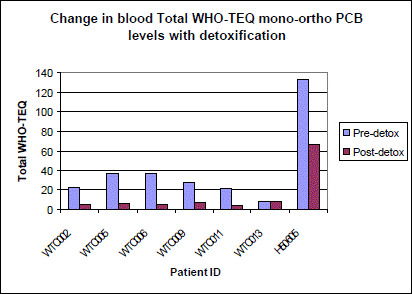 |
 |
||
| Figure 1 | Figure 2 | ||
Here is how the graph should look, reporting all dioxin and PCB levels |
|||
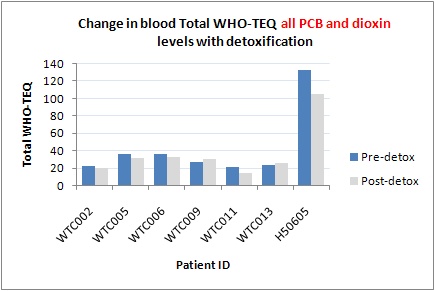 |
|||
| Here is the Excel worksheet used to obtain the real graphes. | Figure 3 | ||
Putting aside for a moment the gross misrepresentation (to put it mildly), it is also interesting to note that according to the title of the flawed graph (figure 1) — "Change in blood total WHO-TEQ mono-ortho PCB levels with detoxification" — NYRWDP chose to show the reduction of mono-ortho PCBs, rather than dioxins, even though these are significantly more toxic than PCBs.[ref][ref] Had NYRWDP chosen to show the reduction in dioxin levels, the graph would have looked like this:
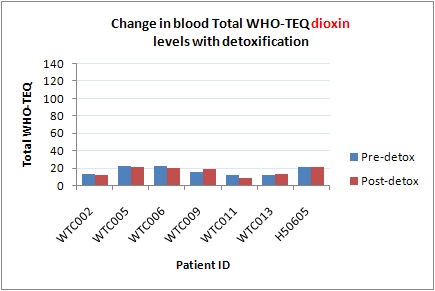 Figure 4 |
Quite unimpressive, which might explain why the more relevant "reduction of dioxin levels" was not chosen in promoting Scientology's "Purification Rundown," even though these chemicals are significantly more toxic.
Dr. James Dahlgren, one of the author of the paper, is an expert in toxicology and is medical director of BWell Clinic, which offers Scientology's detoxification treatment — however, without the disclosure of the treatment being linked to Scientology. (The treatment is described as follow: "Our rigorous sauna-based detoxification program takes at a minimum 14 days and can for some patients take as long as 40 days to complete. Daily exercise, as many as 8 sauna sessions per day, high potency vitamins, nutraceuticals and gradual increases of niacin help to promote the flushing of toxins that the body would not normally eliminate. Other benefits of this detox method include improved fitness from daily exercise, increased mental clarity IQ, and energy, as well as youthful healthy skin, lowered cholesterol, improved cardiovascular function, and general sense of well-being and health.")
On BWell Clinic's web site, in a press release dated September 11, 2006 (still online as of March 21, 2008), one can read that "on average the treatment reduced pollutant levels 65%," referring to the New York Rescue Workers Detoxification Project study above. This 65% can only be obtained when using the wrong values that were used in the deceitful graph above (figure 1). The real reduction, considering all form of dioxins and PCBs is just under 13% (less than 7% if patient H50605 is ignored, since this patient had a delay of 9 months between pre- and post- measurement of dioxin and PCB levels in his blood, as disclosed in the paper). The same faulty study is used by BWell Clinic in what seems a collection of articles for promotional purpose.
Dr. James Dahlgren also co-authored a study presented at Dioxin 2004 conference, in Berlin. The flawed study from NYRWDP is undoubtedly based on the Dioxin 2004 conference paper (see "Dioxin 2004 vs. NYRWDP study" below).
Curiously, the WHO-TEQ values were properly calculated in the Dioxin 2004 document, it is thus surprising that such gross errors were introduced in the NYRWDP study, and even more surprising that Dr. James Dahlgren, a self-described "expert toxicologist", didn't spot these errors in the paper he submitted for publication.
When comparing the two documents, one can note that all references to a control group were removed from the NYRWDP study. Consider these key passages that were removed:
The levels in these rescue workers are for the most part similar to levels measured in the general population. [...]
We find similar concentrations of dioxins, dibenzofurans and PCBs in samples from most of the rescue workers and the general population.
— James Dahlgren et al. (Dioxin 2004 paper)
Why would all references from a control group be removed? Why would references providing a time interval between the pre- and post- levels would be removed? The control group would have shown that there was no abnormal levels of contaminants in the rescue workers and the general population. The time interval between the pre- and post- level measurements would have shown that the variations observed are actually within normal and expected fluctuations.
Also, the flawed study used Toxic Equivalent Factors (TEFs) dating from 1998. In 2005, the World Health Organization released revised TEFs, and more specifically, the toxicity of most mono-ortho PCBs was revised significantly lower.[ref] Had James Dahlgren et al. used the 2005 TEFs, here is how the graphes would have looked (original scale preserved for easy comparison purpose):
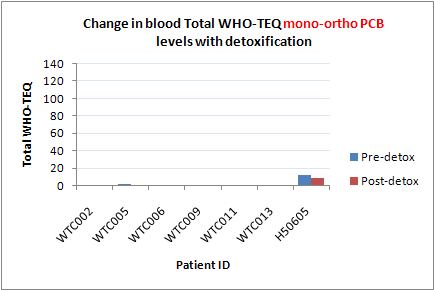 Figure 5 - using 2005 WHO-TEFs |
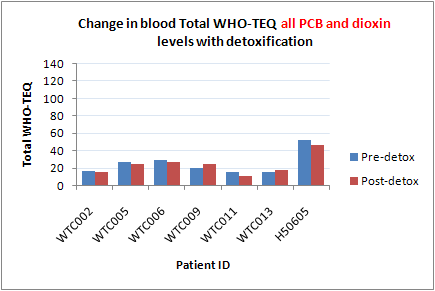 Figure 6 - using 2005 WHO-TEFs |
Which of course isn't impressive, and certainly doesn't justify using public funds to treat individuals who don't show contaminant levels above normal, and with a treatment that shows no evidence whatsoever in reducing these normal levels of contaminants.
The NYRWDP study has been manipulated because it wasn't supportive of the NY detox project, and in this case, clearly Dr. James Dahlgren, and other supporters of L. Ron Hubbard's "Purification Rundown" care more about their own interests than scientific truth.
Two experts comment on Dr. James Dahlgren's deceitful study
| I originally stumbled on the NYRWDP study
while working on
Wikipedia's article on Scientology's "Purification Rundown",
where an editor, a scientologist, was using this study as
a valid citation in support of the treatment. The link
he provided pointed to a document sitting on the NYRWDP's
own web site. It was found that Dr. James Dahlgren's study was actually accepted for publication by Chemosphere on May 26, 2006, under the title Persistent organic pollutants in 9/11 world trade center rescue workers: Reduction following detoxification (see abstract here, or click on thumbnail in sidebar for full article). |
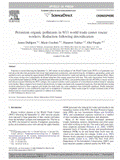 PDF 479KB Source: Chemosphere @ ScienceDirect.Used with express permission of Elsevier Limited. |
|
Two experts, Edmund A.C. Crouch, and Laura C. Green,
from Cambridge
Environmental Inc., wrote a scathing rebuttal to Dr. James
Dahlgren's flawed study, a rebuttal that was accepted for
publication by Chemosphere on May 23, 2007, under the title
Comment
on “Persistent organic pollutants in 9/11 world trade center
rescue workers: Reduction following detoxification” by James
Dahlgren, Marie Cecchini, Harpreet Takhar, and Olaf Paepke
(see
abstract here, or click on thumbnail in sidebar for
full article). Essentially, this rebuttal not only found
the errors in the table/graph, but also finds Dahlgren's
paper to be essentially flawed even after correction of
these errors. They point at the many flaws in the paper:
The paper makes no mention of any [Institutional Review
Board] Review or approval. This is especially worrisome
given the potentially dangerous aspects of the niacin
"treatment," and its basis in (or identity with) the
"purification rundown" advocated by the non-physician,
L. Ron Hubbard, the only basis given by Schnare et al.
(1982). Finally, Chemosphere has a Conflict of Interest/Full
Disclosure policy that does not appear to have been
followed in this case. At least the principal author
appears to have a financial interest in promoting the
"detoxification method" discussed, and indeed the erroneous
claims of this paper are being used to promote his services
(see, for example,
http://www.bwellclinic.com/news2.html).
Overall, then, the paper by Dahlgren et al. (in press)
is highly flawed: to the extent that the paper implies
that the bona fide health problems faced by 9/11 firefighters
and other rescue workers should be addressed in such
a manner, it is unconscionable.
— Edmund A.C. Crouch, Laura C. Green Crouch and Green noted that there was no control group, and that the time interval between pre- and post-measurement of contaminant levels were not mentioned. They might be interested in knowing that the paper was based on the earlier Dioxin 2004 paper, in which there was a control group (which showed no abnormally elevated levels of contaminants), and in which the time interval was (sort of) provided (Fall of 2003 to somewhere on or after April 2004). This information was removed from the NYRWDP study, showing a deliberate intention to misrepresent L. Ron Hubbard's "Purification Rundown" by James Dahlgren et al. Their answer to Dahlgren's paper is a must read, as Dahlgren's study is shamelessly used to promote L. Ron Hubbard's quackery. |
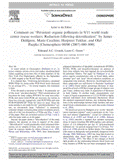 PDF 103KB Source: Chemosphere @ ScienceDirect. Used with express permission of Elsevier Limited. |
James Dahlgren et al. reply to Drs. Crouch and Green
| On September 20, 2007, I read Dr. James Dahlgren's official
reply to Crouch and Green critical commentary, made available
online by Chemosphere on September 18, 2007, under the title
Reply
to Comment of Edmund A.C. Crouch and Laura C. Green, on:
“Persistent organic pollutants in 9/11 world trade center
rescue workers: Reduction following detoxification” by James
Dahlgren, Marie Cecchini, Harpreet Takhar, and Olaf Paepke
(see
abstract here, or click on thumbnail in sidebar for
full article). First, J. Dahlgren contends that Drs. Crouch and Green are correct about the calculation errors in the original paper resulting in the grossly erroneous table/graph:
However, Drs. Green and Crouch are correct in noting
that we did enter an error into the conversion of net
weight to TEQ.
— James Dahlgren et al. I notice that Dr. James Dahlgren reply was received by Chemosphere on June 18, 2007. Yet, as of March 21, 2008, Dr. James Dahlgren's BWell Clinic still claim that "on average the treatment reduced pollutant levels 65%." Similarly, the NYRWDP's web site still refers to the erroneous study. Dr. James Dahlgren further states:
On completion of the therapeutic regimen, WHO-TEQ for
mono-ortho PCBs was decreased by 24.4%. The statistical
analysis of the net reduction of each congener by weight
(lipid based) presented in Table 2 remains correct.
— James Dahlgren et al. The 24.4% decrease of WHO-TEQ mono-ortho level is correct. However, J. Dahlgren still doesn't address key aspects raised by Crouch and Green that could contribute toward explaining this decrease (my emphasis):
The paper by Dahlgren et al. (in press) reports concentrations
only in blood lipids, under unstated ‘‘pre’’ and ‘‘post’’
blood collection conditions, at unspecified time intervals.
Moreover, blood-lipid-levels of these
compounds are well-known to fluctuate:
Sandanger et al. (2003) found similar percentage
decreases in measured blood levels of PCBs in larger
groups of subjects over just 5 days, without
any claim or expectation of decreases in body burden
— Edmund A.C. Crouch, Laura C. Green I will further note that from the Dioxin 2004 paper, it is implied that the sample of seven individuals was not random, and as such, no conclusion involving statistical analysis should be drawn by Dahlgren. I find the next statement in Dahlgren's reply is very interesting:
A number of individual congeners had statistically significant
measured decreases at the completion of this therapeutic
regimen. The 23.4% mean reduction by weight (lipid based)
of all halocarbons measured is represented in Fig. 2
of this letter.
— James Dahlgren et al. The 23.4% decrease in weight of all contaminants is correct. However, this figure is meaningless, as it uses values that have not been normalized using WHO-TEFs (World Health Organization Toxic Equivalent Factors). The TEFs allow to normalize concentration values so that they can be added properly in order to obtain values that represent correctly the overall toxicity level of the measured concentrations of the various chemicals (each one having a different toxicity level). I can't think of any good reason why Dahlgren would suddenly go back to non-WHO-TEQ values in presenting the reduction, thereby ignoring the intrinsic toxicity of each chemicals. This is even more puzzling as Dahlgren later states in his reply (my emphasis):
Although the meaning of the term ‘‘detoxification’’
can be debated, the physiology definition is the metabolic
processes by which the toxic qualities
of a poison or toxin are reduced by the body.
— James Dahlgren et al. Yet, he chose to ignore these "toxic qualities" with his 23.4% figure. Had Dahlgren chosen to keep reporting the reduction in WHO-TEQ units, the reduction would have been 13%, and ignoring patient H50605, who had abnormally elevated PCB concentrations, the reduction would have been under 7%. There is more: if using the WHO-TEFs of 2005 (Dahlgren used obsolete WHO-TEFs of 1998), in which the toxicity of many PCBs was revised significantly lower,[ref] the reduction of all contaminants using Dahlgren statistics would have been 5.6% only (see figure 5 and 6) — 3% if ignoring patient H50605. It is the toxic nature of these chemicals that is of interest, and in essence, using appropriate normalization to express this toxicity would show that the detoxification treatment proposed by Dahlgren is worthless. And again, keep in mind that the levels of contaminants in six of the patients were not out of the ordinary, as per Drs. Crouch and Green. The James Dahlgren and al. paper actually agrees with that, as this is exactly what they reported in their Dioxin 2004 paper (which passages were inexplicably removed from the Chemosphere paper):
The levels in these rescue workers are for the most
part similar to levels measured in the general population.
[...] We find similar concentrations of dioxins, dibenzofurans
and PCBs in samples from most of the rescue workers
and the general population.
— James Dahlgren et al. (Dioxin 2004 paper) In his reply to Drs. Crouch and Green, J. Dahlgren further states:
The remarks from Drs. Green and Crouch seem to be designed
to rebut conclusions that were not stated or intended
by the authors.
— James Dahlgren et al. However, Dr. James Dahlgren and the NYRWDP readily uses the erroneous outcome of the paper in promoting their detoxification treatment (which is obviously Scientology's "Purification Rundown"), this leaves no doubt on the authors' conclusions about the efficiency of their "detoxification treatment". |
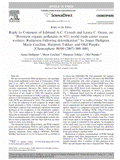 PDF 115KB Source: Chemosphere @ ScienceDirect. Used with express permission of Elsevier Limited. |
|
|
Another statement in Dahglren et al.'s answer:
[...] the variations in cholesterol profiles measured
in this group did not correlate with the measured PCB
reductions (data not shown)
This is surprising, as a previous study involving 240 U.S. women has shown that serum cholesterol (along with age, and location) is a good predictor of plasma concentration of PCBs (Laden et al. 1999: "the most important predictors of PCBs were age, serum cholesterol, and residence in the Midwest or Northeast"). In his reply, Dahlgren points to L. Ron Hubbard's Clear Body, Clear Mind in support of his detoxification treatment (this reference wasn't used in his original, erroneous paper):
First published in 1978 ([Hubbard, L.R., 2002. Clear
Body Clear Mind: The Effective Purification Program.
Bridge Publications]), this standardized therapeutic
regimen is currently in use in a variety of medical
settings to address a diverse range of chemical exposures
including environmental chemicals and illicit drugs.
— James Dahlgren et al. Clear Body, Clear Mind is identified as a Scientology book on Bridge Publications' web site (Bridge Publications "publishes only one author [...] L. Ron Hubbard"). Even more, the book comes with the following disclaimer:
The Purification® program cannot be
construed as a recommendation of medical treatment or
medication. It is not professed to be physical or medical
treatment nor is any such claim made. There are no medical
recommendations or claims for the Purification
program or for any of the vitamin or mineral regimens
described in this book.
— Bridge Publications, Inc. (Medical Disclaimer) This disclaimer is not surprising, as the book is pure pseudo-science (see "The Introduction to 'Clear Body, Clear Mind': Outrageous Nonsense" for further details). Also, in the medical disclaimer, there is the following notice:
Purification is a trademark for the detoxification program
described in this book and is used as such in the writings
of L. Ron Hubbard. It is registered as a service mark
and is owned by
Religious Technology Center.
— Bridge Publications, Inc. (Medical Disclaimer) And here is what the Religious Technology Center say about L. Ron Hubbard's writings (my emphasis):
The Scientology religion is based exclusively upon
L. Ron Hubbard's research, writings and
recorded lectures — all of which
constitute the Scriptures of the religion.
— Religious Technology Center (The Religion of Scientology) Even more, Scientology's "Purification Rundown" itself comes with the following disclaimer:
The Purification Rundown is a Spiritual activity based
on and administered according to the doctrine and practices
of the religion of Scientology as set forth in the writings
of L. Ron Hubbard and adopted by the Church. No part
of the Rundown is intended as the diagnosis, prescription
for, or treatment of any bodily or physical condition
or ill.
— The boards of directors of the Churches of Scientology (Purification Rundown Case Data) The religious nature of the "Purification Rundown" is further confirmed by the lawyer firm representing Bridge Publications, Inc., as seen in their complaint to Google, regarding the posting of the "Purification Rundown Case Data" scripture to the Usenet group alt.religion.scientology (my emphasis):
We also represent Bridge Publications,
Inc. ("BPI"),
exclusive licensee of the copyrights
to the published works of the Scientology religion,
which includes the work, "Purification Rundown Case
Data"
— Moxon & Kobrin, on behalf of Bridge Publications, Inc. (Unauthorized Use of Copyrights Materials) So Dr. James Dahlgren supports (and sells) this detoxification treatment, which is described as a "spiritual activity" part of the Scientology religion by the entity licensing its use. This same "spiritual activity", promoted by Scientology organizations and used deceptively by Narconon and other Scientology secular fronts, has been characterized as dangerous by medical experts — and this was reiterated by Crouch and Green in their reply to Dahlgren et al. Despite all of this, James Dahlgren et al. saw it fit to use Scientology scripture (Clear Body, Clear Mind) as a supporting reference in a scientific paper. |
Ronald Gots, who works for the International Center for Toxicology and
Medicine in Rockville, Md., said he was contracted by the city of Shreveport,
La. Firefighters there thought they had been exposed to PCBs on the job and
persuaded the city to pay for the purification rundown.
Gots reviewed their cases at the request of the insurer and found that PCB levels in the firefighters' bodies had actually gone up during the purification rundown. "I think it's scientifically fallacious to say that you can remove toxic substances from the body this way," Gots said. "Materials stored in fat are not going to be removed in the sweat. It makes no sense." — "Store selling Scientology vitamin regimen raises concerns". St.Petersburg Times. March 28, 1999. |
Dioxin 2004 vs. NYRWDP study
- differences highlighted in red
- simple rewording highlighted in green
Dioxin 2004 study,
 |
NYRWDP study,
 |
Comments | |
| Source | 24th International Symposium on Halogenated Environmental Organic Pollutants and POPs | New York Rescue Workers Detoxification Project | |
| Title | "Persistent Organic Pollutants in 9/11 World Trade Center Rescue Workers" | "Persistent Organic Pollutants in 9/11 World Trade Center Rescue Workers: Reduction following detoxification" | Note that the filename of the NYRWDP study is "dioxin2004.pdf" |
| Authors | James Dahlgren, Arnold Schecter, Harpreet Takhar, Olaf Paepke | James Dahlgren, Arnold Schecter, Marie Cecchini, Harpreet Takhar, Olaf Paepke, Kwabena Nyamekye, Apryl McNeil |
Marie Cecchini
is a Scientologist,
paid researcher for FASE,
a Scientology front. She was also listed as a director of
Narconon, Inc.
from 2000 to 2002. Apryl McNeil and Kwabena Nyamekye are respectively chief executive officer, and associate medical director of Downtown Medical, P.C., the clinic that provides Scientology's detoxification treatment for the New York Rescue Workers Detoxification Project.[ref][ref] Are Arnold Schecter, Harpreet Takhar, and Olaf Paepke aware that their names appear on a scientifically flawed study? |
| Control group data | Supplied | Absent | |
| Toxic Equivalent Factors (TEFs) | Supplied | Absent | Without the TEFs, spotting the misrepresentation is made difficult for the layman, as one has to first obtain the TEFs from another source, and then convert all the data to TEQ before the erroneous data can be spotted. |
| Patient IDs | WB1001, WB2002, WB5005, WB6006, WB7007, WB8008, WB9009, WB10010, WB11011, WB12012, H50605 | WTC002, WTC005, WTC006, WTC009, WTC011, WTC013, H50605 | Even though
the tagging of the patients is expressed slightly differently,
from the data supplied we can see that six of the patients
in the NYRWDP study were part of the earlier Dioxin 2004
study. Curiously, patient WTC013, not part of the Dioxin 2004 study, was the only one having his contaminant levels reported properly in the table/graph. |
| "Introduction" | Rescue workers, including firefighters present at the World Trade Center (WTC) following the September 11, 2001 terrorist attacks were exposed to large quantities of dust, smoke and fumes from the collapse and fire. The fire at the WTC site burned for months. Firefighters, paramedics, police and other personnel labored for weeks and months in the immediate vicinity of the WTC. Personal Protective Equipment (PPE) was not available or was ineffective in preventing the rescue workers from absorbing contaminants. This is based on the rescue workers who reported working without any protection from inhalation, ingestion or dermal exposure to the contaminants. In addition many of the rescue workers developed coughs, headaches, memory disturbance and other symptoms while working on the site. USEPA measurements of benzene, dioxins and polychlorinated biphenyls (PCBs) were elevated in the air in the weeks after the collapse. Dioxins slowly returned to normal background levels after three months. The New York (NY) Department of Environmental Conservation (DEC) analyzed dust/ash samples collected close to the WTC site after September 11, 2001. | Rescue workers, including firefighters present at the World Trade Center (WTC) following the September 11, 2001 terrorist attacks were exposed to large quantities of dust, smoke and fumes from the collapse and fire. The fire at the WTC site burned for months. Firefighters, paramedics, police and are among the approximately 40,000 personnel who labored for weeks and months in the immediate vicinity of the WTC. Personal Protective Equipment (PPE) use was inconsistent, contaminant exposure occurred in a number of ways including absorption and inhalation. Many of the rescue workers developed persistent coughs, headaches, memory disturbance and other symptoms while working on the site. USEPA measurements of benzene, dioxins and polychlorinated biphenyls (PCBs) were elevated in the air in the weeks after the collapse. Dioxins slowly returned to normal background levels after three months. The New York (NY) Department of Environmental Conservation (DEC) analyzed dust/ash samples collected close to the WTC site after September 11, 2001. | |
| The purpose of this study was to characterize body burdens of polychlorinated biphenyls (PCBs), polychlorinated dibenzofurans (PCDFs), and polychlorinated dioxins (PCDDs) from 11 rescue workers who worked at the WTC the day of the collapse and afterwards." | The purpose of this study was two-fold: 1. To characterize body burdens of polychlorinated biphenyls (PCBs), polychlorinated dibenzofurans (PCDFs), and polychlorinated dioxins (PCDDs) in rescue workers and citizens exposed the day of the WTC collapse and afterwards. 2. A pilot evaluation of a treatment method aimed at reducing toxic burden." | ||
| "Methods and Materials" | Participants in the study included self-selected volunteers who all volunteered the day of the collapse and for several days afterwards. These rescue workers were exposed to toxic substances in the air when exposure would have been theoretically the highest. These ten workers used little or no protective respiratory gear during the WTC cleanup and all of them have and currently live in New York. The average age of the rescue workers is 42 (range is 27-52). | Seven men who were present at the World Trade Center collapse and involved in the rescue and cleanup effort presented for treatment at Downtown Medical PC in April 2004 and agreed to participate in this study. Five were employed by the New York Fire Department (FDNY), one was a volunteer rescue worker and one worked nearby at the NY Stock Exchange. All were at the site the day of the collapse and for several weeks afterward when exposure would have been theoretically the highest. The rescue workers used little or no protective respiratory gear during the WTC cleanup and all of them currently live or work in New York. The average age was 44 (range is 37-53). | |
| Ten male rescue workers and one female rescue worker volunteered to have their blood drawn for purposes of measuring the levels of polychlorinated biphenyls (PCBs), polychlorinated dibenzofurans (PCDFs), and polychlorinated dioxins (PCDDs). Blood samples from the rescue workers were collected in the fall of 2003. Fifty milliliters of whole blood was drawn in chemically cleaned glass containers prepared by the analytic laboratory with anticoagulant with Teflon ® tops containing no paper products. Blood was frozen and sent frozen on dry ice to Germany for polychlorinated dioxin and furan analysis at ERGO Laboratory, a World Health Organization certified dioxin laboratory. Analysis was performed by gas chromatography/high-resolution mass spectrometry by methods previously described. A comparison blood sample was obtained from 100 leftover blood samples from a Dallas, Texas clinic that was pooled and served as controls. Measured levels have been converted to dioxin toxic equivalents (TEQ) using the 1998 WHO toxic equivalency factors (TEFs). | These individuals volunteered to have their blood drawn for purposes of measuring the levels of polychlorinated biphenyls (PCBs), polychlorinated dibenzofurans (PCDFs), and polychlorinated dioxins (PCDDs). Fifty milliliters of whole blood was drawn in chemically cleaned glass containers prepared by the analytic laboratory with anticoagulant with Teflon ® tops containing no paper products. Blood was frozen and sent frozen on dry ice to Germany for polychlorinated dioxin and furan analysis at ERGO Laboratory, a World Health Organization certified dioxin laboratory. Analysis was performed by gas chromatography/high-resolution mass spectrometry by methods previously described. Measured levels have been converted to dioxin toxic equivalents (TEQ) using the 1998 WHO toxic equivalency factors (TEFs). | It is
interesting to note that the information about when the
pre-treatment blood samples were collected was removed.
It would seem the patients went through NYRWPD's detox treatment
months after their contaminant levels were measured
(fall of 2003 to April 2004). Also, all mentions of a control group have been removed. |
|
| These individuals
also participated in a series of testing including thorough
medical examination, completion of structured health and
symptom questionnaires, and neurophysiologic testing. Following examination and tests, the study subjects enrolled in a previously described method of detoxification, a treatment regimen including exercise, sauna bathing and vitamin and mineral supplements developed to address the adverse effects of chemical exposures. On completion of treatment, all had blood drawn for post-treatment testing and complete follow-up examination as described above. |
|||
| "Results" ("Findings" in NYRWDP study) | Table 1 displays the mean dioxin levels and mean TEQ levels by congener in the group of rescue workers. The levels in these rescue workers are for the most part similar to levels measured in the general population. | [This table is absent] | Again, mention of the control group was removed. Could it be that it would be embarrassing to use public funds to "treat" people that actually have contaminant levels that "are for the most part similar to levels measured in the general population"? |
| The measured dioxin, dibenzofuran, and PCB congener levels and TEQ for the each individual rescue worker is presented in Table 2. Four rescue workers (HB50605, WB5005, WB 8008, WB 9009) have elevated 2,3,3',4,4'-PeCB (105) and 2,3',4,4',5-PeCB (118). The rest of the rescue workers were comparable to levels measured in the U.S. general population. Patient H 5-0605 was a firefighter who we tested in May 2003. PCB levels for Patient H 5-0605 are also elevated. | The measured dioxin, dibenzofuran, and PCB congener levels and TEQ for each subject before and after detoxification is presented in Table 1 and represented by graph in Figure 1. Prior to detoxification treatment, Five rescue workers (HB50605, WB5005, WB8008, WB9009, WB13013) have elevations in 2,3,3',4,4'-PeCB (105), 2,3',4,4',5-PeCB (118) and/or 2,3,3',4,4',5- HxCB (156). Patient H 5-0605 was a firefighter who we initially tested in May 2003. | ||
| Pre treatment total mono-ortho PCB blood levels ranged from 19 ppb to 416 ppb (WHO-TEQ 8.2-133.3) with a geometric mean of 41 ppb (WHO-TEQ 29.3). | Wrong.
This should read: "Pre treatment total mono-ortho PCB blood levels ranged from 19 ppb to 405 ppb (WHO-TEQ 6.0-91.7) with a geometric mean of 41 ppb (WHO-TEQ 10.3)" |
||
| Following detoxification, calculated WHO-TEQs for mono-ortho PCB blood levels averaged a 65% decrease. Measured levels ranged from 15 ppb to 302ppb (WHO-TEQ 3.6-67) with a geometric mean of 32 ppb (WHO-TEQ 8). Non-ortho WHO-TEQs averaged a 57% decrease. | As with
mono-ortho PCB levels, non-ortho PCB levels are not calculated
properly in the table: therefore, there is no such thing
as 65% and 57% decrease. The real decreases are:
|
||
| Brominated dioxins, brominated dibenzofurans, and polybrominated diphenyl ethers were not elevated in rescue workers as compared to the general population (data not shown). | Brominated dioxins, brominated dibenzofurans, and polybrominated diphenyl ether congeners were at low levels or below the limit of detection (data not shown). | ||
| "Discussion" | These individuals
presented with a similar pattern of health complaints and
manifested symptoms including respiratory impairment, mental/emotional
distress (two met PTSD criteria), decreased sensory systems,
chronic muscle and joint pain, gastrointestinal disorders,
and skin rashes. These symptoms completely resolved or were
satisfactorily improved on completion of treatment. The
neurophysiological test results also improved. (data not
shown). In view of the documented persistence of adverse health effects in individuals exposed during the attack and collapse of the World Trade Center, it is important to not just document symptoms and possible causes, it is essential to identify workable treatment modalities. The purpose of characterizing levels of these compounds was to determine whether compounds of this class could be detected in this population this long after exposure and, assuming detection, whether their levels could be reduced by detoxification treatment. It is useful to have a marker compound for use in future studies planned to evaluate the use of this treatment method for this exposure. |
||
| [Here appears a paragraph that appeared last in the original document, see below] | |||
| The elevated concentrations of the PCBs found in some rescue workers appear to be consistent with the several dozen firefighters who were noted to have elevated PCB levels above 12 PPB utilizing the Webb and McCall technique (General Population average = 6ppb as reported by lab). | The elevated concentrations of the PCB congeners found in some rescue workers appear to be consistent with the several dozen firefighters tested by FDNY and were noted to have elevated PCB levels above 12 PPB utilizing the Webb and McCall technique (general population average by this technique = 6ppb as reported by lab). These levels are considerably higher than what would be expected in the general population, and consistent with levels seen in occupational exposure to PCBs. | ||
| A particular firefighter (Patient HB50605) provided us with results of his PCB value of 32ppb (Webb and McCall technique) on January 9th, 2002. The same firefighter was tested again in September 9th, 2002, where his results were 13ppb (Webb and McCall technique). He had his blood drawn and analyzed for dioxin, furan and PCB at ERGO laboratory in May 2003 (Table 2). The results show that his PCB levels were still elevated. This firefighter (Patient H 5-0605) had also worked on the day of the collapse and several subsequent days later. | A particular firefighter (Patient HB50605) provided us with results of two prior PCB tests (based on Arochlor 1260, Webb and McCall technique). Test results were 32ppb on January 9th, 2002 and 13ppb on September 9th, 2002. He had his blood drawn and analyzed for dioxin, furan and PCB at ERGO laboratory in May 2003 (Table 2). Using a more reliable and sensitive technique his levels measured 416ppb (WHO-TEQ 133.3). This firefighter (Patient H 5-0605) had also worked on the day of the collapse and several subsequent days later. | The added
sentence should read: "Using a more reliable and sensitive technique his levels measured 405ppb (WHO-TEQ 91.7)" |
|
| A study by Edelman et al, reported an unanticipated increase in heptachlorodibenzodioxin and heptachlorodibenzofuran, which was associated with exposure to WTC. However, the authors do not presume the exposure to be WTC specific. | A study by Edelman et al, reported an unanticipated increase in heptachlorodibenzodioxin and heptachlorodibenzofuran, which was associated with exposure to WTC. However, the authors do not presume the exposure to be WTC specific. | ||
| We find similar concentrations of dioxins, dibenzofurans and PCBs in samples from most of the rescue workers and the general population. Four rescue workers did however have elevated levels of 2,3,3',4,4'-PeCB (105) and 2,3',4,4',5-PeCB (118). Further inquiry is being conducted to determine what the three subjects had in common during the period of exposure. We speculate possible reasons for these three subjects to have elevated levels might include higher exposure, longer exposure times and less protection. | Again,
removal of the mention that the concentrations of contaminants
are for the most part similar to that of the general population. Also, note that from this passage it can be understood that four individuals in the sample were picked because they had abnormally high levels of two particular congeners, which means the selection of individuals was by no mean random: the individuals were picked because they had high, non-TEQ, levels. Once levels are converted to TEQ, there is only one individual showing abnormally high levels of PCBs (his doxin levels are normal though, as seen in figure 4.) |
||
| [The following paragraph actually appears earlier, see above] | |||
| The concentrations reported in this paper, with some notable exceptions (WB-5005, WB 8-008, WB 9-009), are not elevated. Dioxins and dibenzofurans have long half-lives. The rescue workers we studied might have been exposed to high dioxin levels but for too short a time period to note elevation this long after exposure, despite previous positive findings decades after exposure in chemical workers. We only can measure elevated dioxins in the human body if the total uptake adds significantly to the body burden. For comparison: The intake via food ranges between 50 and 100 pg TEQ/day. A typical air concentration may be at 0.05 pg TEQ/m3. Even at a 1000 times elevated air concentration, 24 h inhalation (20 m3) adds “only” 1000 pg to the body burden (equivalent to about 10 days additional uptake from food). | This was a complex exposure to many different compounds and under many different circumstances. Various reports suggest that PCBs, PCDDs, PCDFs and brominated flame retardants were not above background in the dust at the WTC site but that the large volume of material could lead to significant ambient exposure. These compounds have long half-lives. It is unclear why PCBs but not PCDDs, PCDFs or brominated flame retardants were elevated, despite previous positive findings decades after exposure in chemical workers. We only can measure elevated levels in the human body if the total uptake adds significantly to the body burden. For comparison: The intake via food ranges between 50 and 100 pg TEQ/day. A typical air concentration may be at 0.05 pg TEQ/m3. Even at a 1000 times elevated air concentration, 24 h inhalation (20 m3) adds “only” 1000 pg to the body burden (equivalent to about 10 days additional uptake from food). | ||
| Additional limitations of our study include a small study sample. | |||
| The symptoms presented
by the seven men in this group matched the pattern seen
in studies of WTC-exposed populations. A 2003 Mt. Sinai/NIOSH/CDC
analysis of 250 WTC screening program participants documents
that approximately half the sample had persistent WTC-related
pulmonary, ENT and/or mental health symptoms that persisted
a year following the exposures. The observed persistent
symptomatology and its improvements with detoxification
is consistent with medical records from an additional 286
WTC-exposed men and women who have completed detoxification
treatment to date. This pilot is limited by its small sample size. No relationships can be inferred between the PCB contamination found and the observed symptoms, or between reduction in these levels and the improvements noted following treatment. However, it is interesting that studies evaluating the adverse effects of high levels of PCB exposure commonly list neurobehavioral, rashes and acne, nausea and other gastrointestinal problems. Studies in workers suggest that exposure to PCBs may also cause irritation of the nose and lungs, changes in the blood and liver, and depression and fatigue. Further, previous studies of PCB-exposed firefighters have demonstrated neurologic symptom improvement on completion of this treatment. As well, prior studies using this method of detoxification showed reduced body burden of PCBs, PBBs and chlorinated pesticides. The data presented here will be used to inform a larger study where correlations may be further tested. Even three years after the WTC attacks, thousands of exposure victims continue to have persistent illness. New approaches to this public health crisis are urgently needed. |
|||
| Number of references | 10 | 18 (there is a error in the numbering, "8" is repeated twice) |